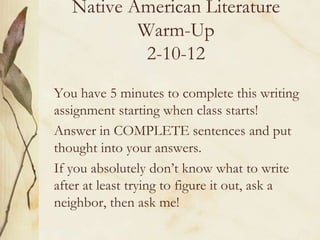Myth
This document discusses Native American myths and their importance in Native American culture. It begins by defining what myths are - traditional stories that involve supernatural elements and attempt to explain natural phenomena or teach moral lessons. It notes that myths were an important part of oral tradition for Native Americans. The document then discusses some common characteristics and purposes of Native American myths, such as explaining origins or cultural values. Students are then assigned to study examples of Native American origin myths in small groups and present their myth to the class. They are also given a writing assignment to either create their own myth or interview an elder about an oral tradition passed down through generations.

Recommended
Recommended
More Related Content
What's hot
What's hot (20)
Similar to Myth
Similar to Myth (20)
Recently uploaded
Recently uploaded (20)
Myth
- 1. Native American Literature Warm-Up 2-10-12 You have 5 minutes to complete this writing assignment starting when class starts! Answer in COMPLETE sentences and put thought into your answers. If you absolutely don’t know what to write after at least trying to figure it out, ask a neighbor, then ask me!
- 2. Essential Questions Why do people communicate? How do people communicate? How do audience and purpose determine style?
- 3. Objectives By the completion of this lesson students will be able to: To analyze the characteristics of a myth and evaluate how Native Americans used it. To analyze the Western perspective of myths and myth making
- 4. So, what is a myth? •The word itself comes from the Greek “mythos” which originally meant “speech.” •It is a traditional story explaining how the world and the things in it came to be.
- 5. Myth •A traditional story that deals with gods, goddesses, heroes, and/or supernatural forces. •A myth may explain a belief, custom, or a force of nature
- 6. Myths • Contain supernatural elements • Often explain the unexplainable • Have also been told in order to teach a moral lesson. • All cultures have myths, though often do not see their stories as myth but as fact. • reflect the culture of the people who create them • Use metaphors
- 7. Native American Myths- • The First Nation's Peoples had a value system. There were only four commandments from the Great Spirits: • 1.Respect Mother Earth 2.Respect the Great Spirit 3.Respect our fellow man and woman 4.Respect for individual freedom
- 8. Origin Myths • Every origin myth is a story of creation: origin myths describe how some new reality came into existence
- 9. Oral tradition • Native American myths originated as oral tradition: Stories passed down verbally • Native American creating myths were not written down until just a few hundred years ago.
- 10. These Native American myths.. • The World on the Turtle’s Back, When Grizzlies Walked Upright, Navajo Origin Legend, The Sky Tree, Coyote Finishes His Work • All offer explanations of where the people who inhabit the Earth came from. • What other sources take on the challenge of explaining this phenomenon? - the Bible, geneticists
- 11. Alright, let’s get to it! • You will be divided into groups (we need 3) each having a different myth to study and present. Just scoot next to your neighbors. • Suggestion: Read the myth silently first and then read it aloud to emphasize the importance of the oral tradition • Assign the following roles within your group: recorder, creativity director, teacher • Then, complete the response sheet- one per group. Everyone should generate ideas but the note taker records. • Then, discuss how best to present your myth- perform a skit, do an oral reading, create a picture- you must TEACH the myth to the class • Finally, presentations!
- 12. Classwork/Homework Classwork 1. Create your own mythic tale! This can be about anything. What story will you tell your kids one day about how the world was created? Tossing out all that you know biblically, creatively come up with a new version. One page, single spaced, college ruled paper. Homework 2. This myth is part of the oral tradition of stories being told in various ways- usually depending on beliefs and customs. Interview someone “older” to find a story that has been passed down from generation to generation. One page, single spaced, college ruled paper. Or two pages typed, double space, 12 pt font. Due Monday, 2/13/12
